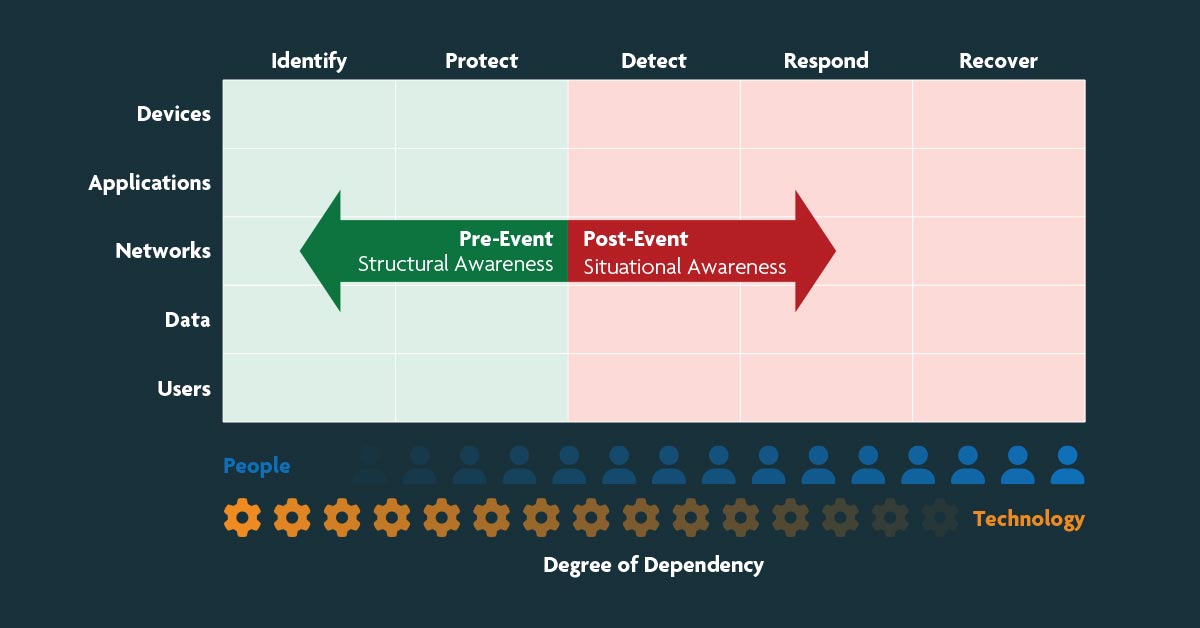How the Cyber Defense Matrix Helps MSPs Select Cybersecurity Solutions

The cybersecurity market is growing fast. With so many options, you need a way to systematically evaluate and organize tools to ensure optimal coverage.
The global cybersecurity market is projected to double, if not triple, by 2030. Valued at around $200 billion in 2022, it’s on track to soon top $400 billion in the wake of skyrocketing cyber attacks and a “security awakening” among businesses. McKinsey even maintains the gap between the vended market (10%) and the fully addressable market (90%) for security solutions amounts to a staggering $1.5 trillion to $2 trillion.
As demand takes off, managed service providers (MSPs) have an important role to play as their small to medium-sized business (SMBs) clients increasingly look to them to shoulder not only IT management but cybersecurity.
But in a sea of choices, how do you know which solution, or solutions, best meets the security needs of your customers?
Understanding the Cyber Defense Matrix
To answer that question, Sounil Yu, a seasoned security scientist, created the Cyber Defense Matrix. Yu likens the cybersecurity market to a grocery store where all items have been placed in a big pile. Without a way to systematically understand, manage, and organize their cybersecurity efforts, MSPs cannot possibly find the right tool or compare products.
He notes, “Because the cybersecurity community does not use consistent terminology to describe what we need, there is much confusion about what many vendor products actually do. Instead of a clear articulation of a product’s capabilities, we are bombarded with overused, trendy jargon that usually leaves us wondering if the product can really solve any of our problems. Some security teams even organize themselves according to the jargon.”
To introduce a sense of order, Younil developed a comprehensive framework that became the Cyber Defense Matrix. Ingenious in its simplicity, the matrix consists of two dimensions:
- The Five Functions of the NIST Cybersecurity Framework: Identify, Protect, Detect, Respond, and Recover. (Reading tip: Understanding the Big Picture of Cybersecurity Starts with NIST)
- The Five Asset Classes: Devices, Applications, Networks, Data, and Users (DAN DU).
Then, at the bottom of the grid, a continuum illustrates the varying reliance on technology, people, and processes as you advance through the five operational functions outlined in the NIST Cybersecurity Framework.

So, how can you leverage the matrix to your benefit?
1. Identifying gaps and prioritizing investments
The Cyber Defense Matrix allows MSPs to visualize their existing security measures and identify any gaps in coverage. By examining the intersections between the five functions and asset classes, MSPs can pinpoint areas where they may lack protection or where additional investments are necessary. This helps you make informed decisions about allocating resources and prioritizing the adoption of new cybersecurity solutions.
2. Ensuring comprehensive security coverage
The matrix's structured approach helps MSPs ensure that they have comprehensive security coverage across their clients' digital infrastructure. By considering all asset classes and functions, MSPs can avoid blind spots and ensure that every aspect of their clients' cybersecurity needs is addressed. This comprehensive coverage, led by vulnerability management, is crucial in today's complex threat landscape, where a single vulnerability can lead to significant consequences.
3. Streamlining security processes and communication
The matrix provides a common language and framework for MSPs to talk about their cybersecurity posture with clients, partners, and internal teams. By using consistent terminology and organizing security solutions within the matrix, you can avoid confusion and misunderstandings. In other words, it allows you to communicate more effectively about the value of investing in certain solutions over others. This improved communication can help MSPs establish trust with their clients, demonstrating their expertise in providing robust security solutions.
4. Benchmarking and continuous improvement
The Cyber Defense Matrix allows MSPs to benchmark their cybersecurity capabilities against industry best practices and guidelines, such as the NIST Cybersecurity Framework. By aligning their security strategies with these recognized standards, you can demonstrate your commitment to maintaining a high level of security for your clients. The matrix encourages continuous improvement by making it easy to identify areas where additional efforts or investments may be needed to stay ahead of emerging threats.
5. Balancing people, process, and technology
In times of talent gaps, the matrix can be particularly helpful in identifying which solutions rely more on technology than human resources. As the graphic illustrates, the Identify function is the least people-dependent while the Recover function requires more people than technology. The need for process, however, remains the same across the different functions.
By considering the dependencies on each of these elements, you can identify potential imbalances in your security strategies. This awareness enables you to make adjustments and ensure that your approach is well-rounded, addressing all aspects of cybersecurity. It’s only by addressing the first two functions — Identify and Protect — that you can reduce the risk of suffering a breach.
6. Adapting to the evolving threat landscape
The cybersecurity landscape is continually evolving, with new threats and vulnerabilities emerging regularly. The Cyber Defense Matrix helps MSPs stay agile and adapt their security strategies to these changes. By regularly reviewing and updating the matrix, you can ensure that your cybersecurity solutions remain relevant and effective, protecting your clients from the latest threats.
7. Educating clients on cybersecurity best practices
The Cyber Defense Matrix can also serve as an educational tool for MSPs to help their clients understand the importance of a comprehensive and well-structured cybersecurity strategy. By using the matrix to demonstrate the various aspects of security and the need for coverage across all asset classes and functions, you can raise awareness among your clients and lead an insightful dialogue on, for instance, the value of investing in vulnerability assessment and remediation to harden the attack surface to fend off malicious actors.
Final word
The Cyber Defense Matrix is an effective tool for MSPs as they navigate the myriad of cybersecurity solutions. By providing a clear, structured framework, it helps you identify gaps in your security coverage, streamline communication, benchmark against industry best practices, and adapt to the evolving threat landscape.
Need expert help? We identify and remediate vulnerabilities before they become breaches. Contact us today to learn more or seize the chance to try the ConnectSecure Vulnerability Manager with a 14-day free trial.

Keep reading
What is Vulnerability Management?
5 Cybersecurity Trends to Watch (No. 1: Companies Up Focus on Technology)
The Lessons from Log4j and Other Zero-Day Attacks

